External links
| This optics-related article is a stub. You can help Wikipedia by expanding it. |
A polychromator is an optical device that is used to disperse light into different directions to isolate parts of the spectrum of the light. A prism or diffraction grating can be used to disperse the light. Unlike a monochromator, it outputs multiple beams over a range of wavelengths simultaneously. Monochromators have one exit slit and one wavelength at a time can pass through that slit. Polychromators have multiple exit slits, each of which allows a different wavelength to pass through it. A detector is placed after each slit so that the light at each wavelength is measured by a different detector. Polychromators are often used in spectroscopy.
Spectrograph is a closely related term. Spectrographs generally do not make use of exit slits. Instead, they use a single spatially selective detector (such as photographic film or a charge-coupled device). Spectrographs are generally used to observe a continuous range of wavelengths, while polychromators are more commonly used to observe several discrete wavelengths, leaving gaps in-between.
| This optics-related article is a stub. You can help Wikipedia by expanding it. |
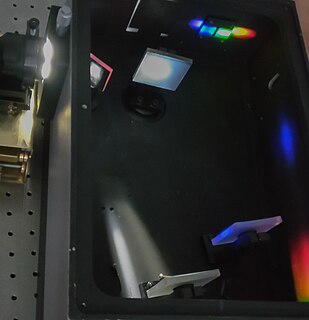
An optical spectrometer is an instrument used to measure properties of light over a specific portion of the electromagnetic spectrum, typically used in spectroscopic analysis to identify materials. The variable measured is most often the light's intensity but could also, for instance, be the polarization state. The independent variable is usually the wavelength of the light or a unit directly proportional to the photon energy, such as reciprocal centimeters or electron volts, which has a reciprocal relationship to wavelength.
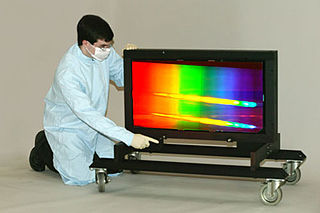
In optics, a diffraction grating is an optical component with a periodic structure that splits and diffracts light into several beams travelling in different directions. The emerging coloration is a form of structural coloration. The directions of these beams depend on the spacing of the grating and the wavelength of the light so that the grating acts as the dispersive element. Because of this, gratings are commonly used in monochromators and spectrometers.
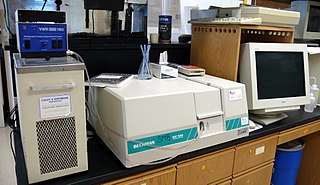
Ultraviolet–visible spectroscopy or ultraviolet–visible spectrophotometry refers to absorption spectroscopy or reflectance spectroscopy in part of the ultraviolet and the full, adjacent visible spectral regions. This means it uses light in the visible and adjacent ranges. The absorption or reflectance in the visible range directly affects the perceived color of the chemicals involved. In this region of the electromagnetic spectrum, atoms and molecules undergo electronic transitions. Absorption spectroscopy is complementary to fluorescence spectroscopy, in that fluorescence deals with transitions from the excited state to the ground state, while absorption measures transitions from the ground state to the excited state.

X-ray fluorescence (XRF) is the emission of characteristic "secondary" X-rays from a material that has been excited by being bombarded with high-energy X-rays or gamma rays. The phenomenon is widely used for elemental analysis and chemical analysis, particularly in the investigation of metals, glass, ceramics and building materials, and for research in geochemistry, forensic science, archaeology and art objects such as paintings

In chemistry, spectrophotometry is the quantitative measurement of the reflection or transmission properties of a material as a function of wavelength. It is more specific than the general term electromagnetic spectroscopy in that spectrophotometry deals with visible light, near-ultraviolet, and near-infrared, but does not cover time-resolved spectroscopic techniques.

Fluorescence spectroscopy is a type of electromagnetic spectroscopy that analyzes fluorescence from a sample. It involves using a beam of light, usually ultraviolet light, that excites the electrons in molecules of certain compounds and causes them to emit light; typically, but not necessarily, visible light. A complementary technique is absorption spectroscopy. In the special case of single molecule fluorescence spectroscopy, intensity fluctuations from the emitted light are measured from either single fluorophores, or pairs of fluorophores.

A monochromator is an optical device that transmits a mechanically selectable narrow band of wavelengths of light or other radiation chosen from a wider range of wavelengths available at the input. The name is from the Greek roots mono-, "single", and chroma, "colour", and the Latin suffix -ator, denoting an agent.

X-ray spectroscopy is a general term for several spectroscopic techniques for characterization of materials by using x-ray excitation.
An ultrafast monochromator is a monochromator that preserves the duration of an ultrashort pulse. Monochromators are devices that select for a particular wavelength, typically using a diffraction grating to disperse the light and a slit to select the desired wavelength; however, a diffraction grating introduces path delays that measurably lengthen the duration of an ultrashort pulse. An ultrafast monochromator uses a second diffraction grating to compensate time delays introduced to the pulse by the first grating and other dispersive optical elements.
A spectroradiometer is a light measurement tool that is able to measure both the wavelength and amplitude of the light emitted from a light source. Spectrometers discriminate the wavelength based on the position the light hits at the detector array allowing the full spectrum to be obtained with a single acquisition. Most spectrometers have a base measurement of counts which is the un-calibrated reading and is thus impacted by the sensitivity of the detector to each wavelength. By applying a calibration, the spectrometer is then able to provide measurements of spectral irradiance, spectral radiance and/or spectral flux. This data is also then used with built in or PC software and numerous algorithms to provide readings or Irradiance (W/cm2), Illuminance, Radiance (W/sr), Luminance (cd), Flux, Chromaticity, Color Temperature, Peak and Dominant Wavelength. Some more complex spectrometer software packages also allow calculation of PAR µmol/m²/s, Metamerism, and candela calculations based on distance and include features like 2- and 20-degree observer, baseline overlay comparisons, transmission and reflectance.
A spectrofluorometer is an instrument which takes advantage of fluorescent properties of some compounds in order to provide information regarding their concentration and chemical environment in a sample. A certain excitation wavelength is selected, and the emission is observed either at a single wavelength, or a scan is performed to record the intensity versus wavelength, also called an emission spectrum. The instrument is used in fluorescence spectroscopy.

In optics, a dispersive prism is an optical prism, usually having the shape of a geometrical triangular prism, used as a spectroscopic component. Spectral dispersion is the best known property of optical prisms, although not the most frequent purpose of using optical prisms in practice. Triangular prisms are used to disperse light, that is, to break light up into its spectral components. Different wavelengths (colors) of light will be deflected by the prism at different angles, producing a spectrum on a detector. This is a result of the prism's material index of refraction varying with wavelength. By application of Snell's law, one can see that as the wavelength changes, and the refractive index changes, the deflection angle of a light beam will change, separating the colors of the light spatially. Generally, longer wavelengths (red) thereby undergo a smaller deviation than shorter wavelengths (blue) where the refractive index is larger.

The Cosmic Origins Spectrograph (COS) is a science instrument that was installed on the Hubble Space Telescope during Servicing Mission 4 (STS-125) in May 2009. It is designed for ultraviolet (90–320 nm) spectroscopy of faint point sources with a resolving power of ≈1,550–24,000. Science goals include the study of the origins of large scale structure in the universe, the formation and evolution of galaxies, and the origin of stellar and planetary systems and the cold interstellar medium. COS was developed and built by the Center for Astrophysics and Space Astronomy (CASA-ARL) at the University of Colorado at Boulder and the Ball Aerospace and Technologies Corporation in Boulder, Colorado.

An echelle grating is a type of diffraction grating characterised by a relatively low groove density, but a groove shape which is optimized for use at high incidence angles and therefore in high diffraction orders. Higher diffraction orders allow for increased dispersion (spacing) of spectral features at the detector, enabling increased differentiation of these features. Echelle gratings are, like other types of diffraction gratings, used in spectrometers and similar instruments. They are most useful in cross-dispersed high resolution spectrographs, such as HARPS, PRL Advanced Radial Velocity Abu Sky Search (PARAS), and numerous other astronomical instruments.
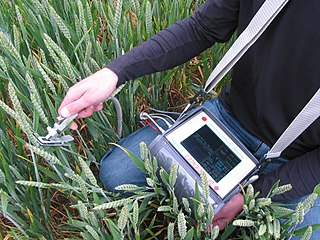
A fluorometer or fluorimeter is a device used to measure parameters of visible spectrum fluorescence: its intensity and wavelength distribution of emission spectrum after excitation by a certain spectrum of light. These parameters are used to identify the presence and the amount of specific molecules in a medium. Modern fluorometers are capable of detecting fluorescent molecule concentrations as low as 1 part per trillion.

Fourier-transform infrared spectroscopy (FTIR) is a technique used to obtain an infrared spectrum of absorption or emission of a solid, liquid or gas. An FTIR spectrometer simultaneously collects high-spectral-resolution data over a wide spectral range. This confers a significant advantage over a dispersive spectrometer, which measures intensity over a narrow range of wavelengths at a time.
The SOPHIEéchelle spectrograph is a high-resolution echelle spectrograph installed on the 1.93m reflector telescope at the Haute-Provence Observatory located in south-eastern France. The purpose of this instrument is asteroseismology and extrasolar planet detection by the radial velocity method. It builds upon and replaces the older ELODIE spectrograph. This instrument was made available for use by the general astronomical community October 2006.
An integral field spectrograph, or a spectrograph equipped with an integral field unit (IFU), is an optical instrument combining spectrographic and imaging capabilities, used to obtain spatially resolved spectra in astronomy and other fields of research such as bio-medical science and earth observation.
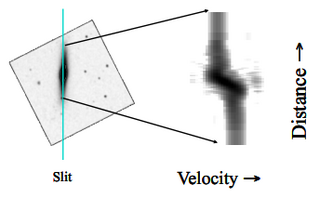
In astronomy, long-slit spectroscopy involves observing a celestial object using a spectrograph in which the entrance aperture is an elongated, narrow slit. Light entering the slit is then refracted using a prism, diffraction grating, or grism. The dispersed light is typically recorded on a charge-coupled device detector.
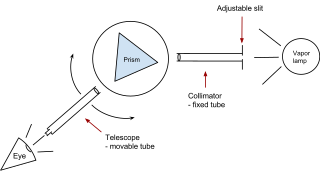
A prism spectrometer is an optical spectrometer which uses a dispersive prism as its dispersive element. The prism refracts light into its different colors (wavelengths). The dispersion occurs because the angle of refraction is dependent on the refractive index of the prism's material, which in turn is slightly dependent on the wavelength of light that is traveling through it.